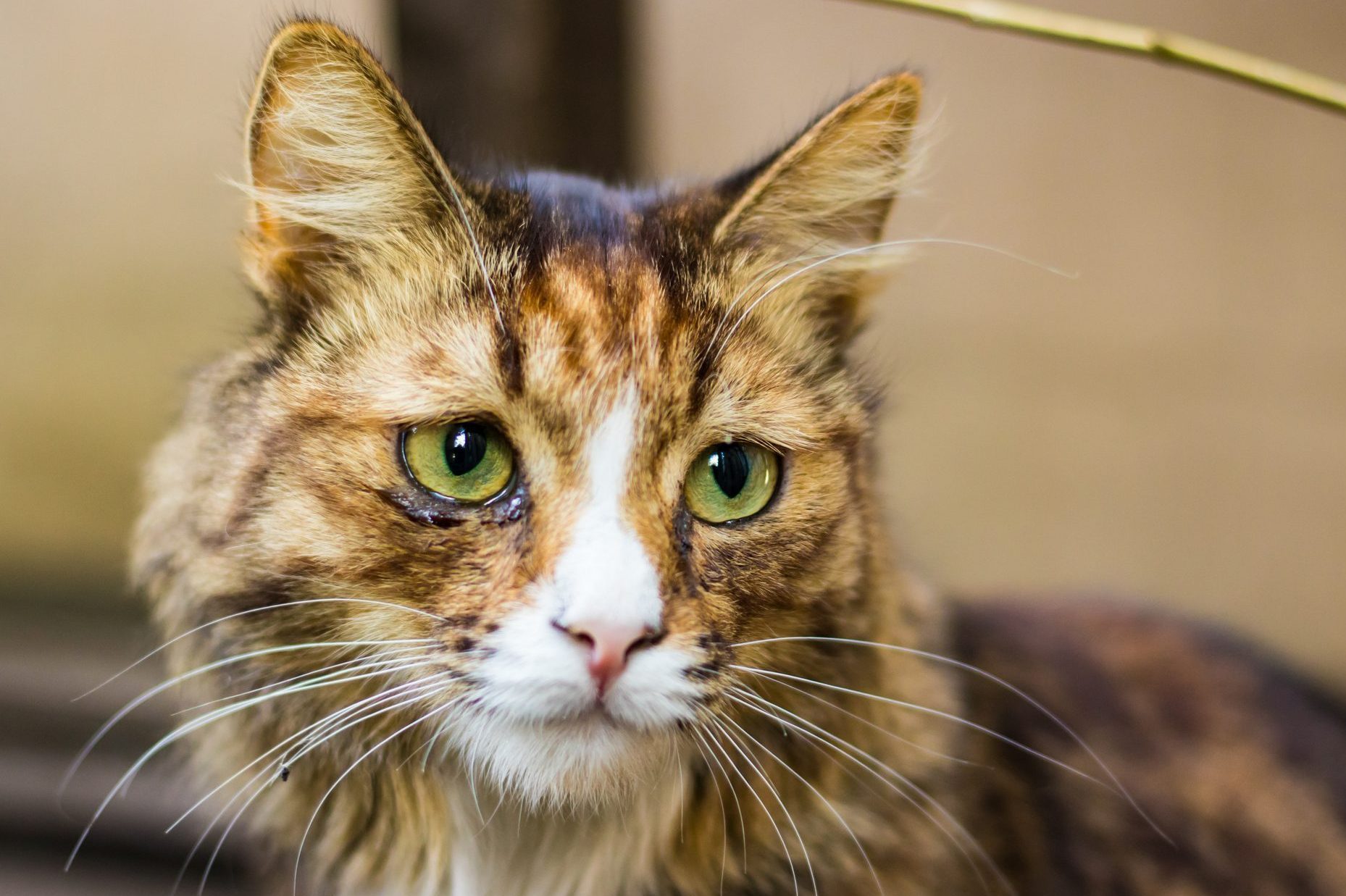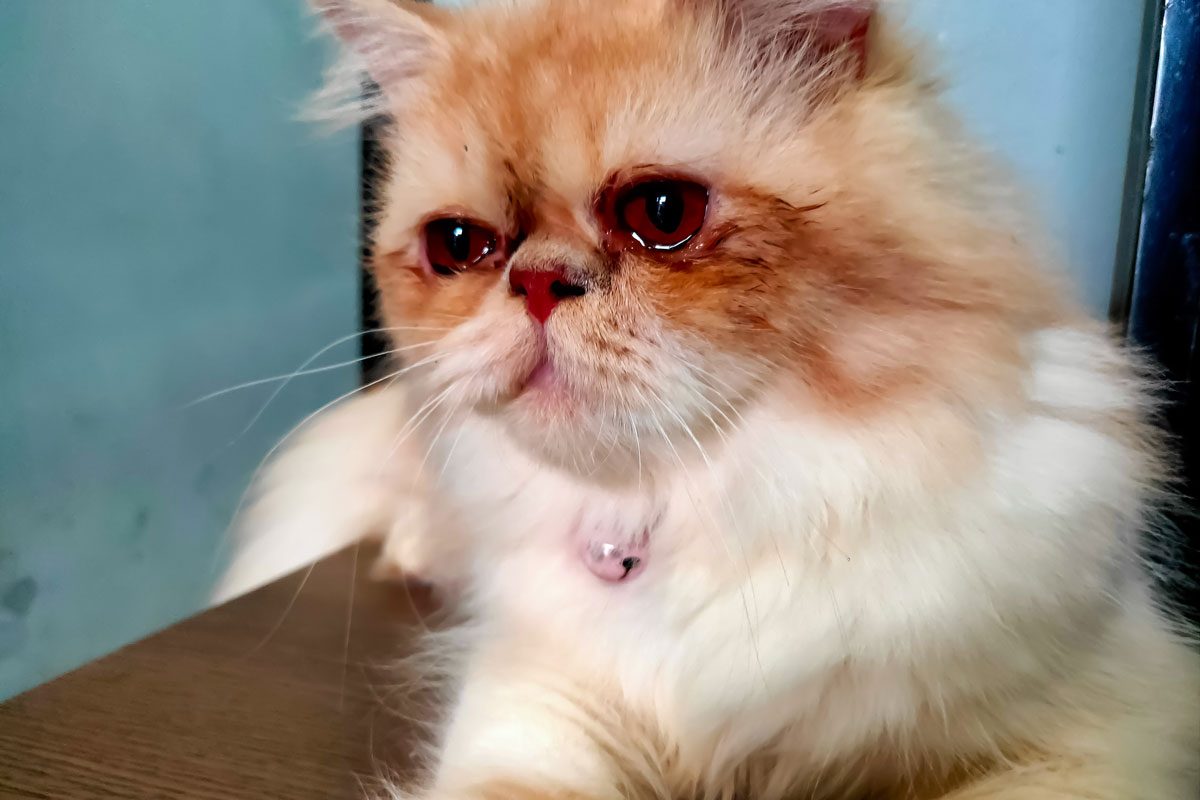Anyone who has ever noticed tears in their cat's eyes has probably wondered, Can cats cry? Read on to find out the answer.

Can Cats Cry? A Vet Explains

If you’re like most cat parents, you’d give almost anything to keep your favorite feline happy. So the sight of even a single tear glistening in your cat’s eye can be jarring. But can cats cry? Do kitty tears mean your precious furball is unhappy or depressed?
Before you set off in search of some feline Prozac to soothe your pet’s psyche, take it from a veterinarian. “If you see tears in your cat’s eye, there’s definitely something going on,” says Ashley Saffire, DVM. “It just may not be what you think.”
Read on to find out if cats cry and what causes this apparent weepiness.
Get Reader’s Digest’s Read Up newsletter for more pets, humor, cleaning, travel, tech and fun facts all week long.
Do cats cry?
Yes, those are tears streaming down your cat’s face—like humans, cats produce tears to keep the eyes lubricated—but in cats, a torrent of tears is not the result of an emotional condition. It’s the result of a physical one. “I see a lot of cats come in with eye discharge or excessive tearing, and other reasons,” says Dr. Saffire. “But it’s definitely not because your cat is sad.”
What causes excessive tearing in cats?

“Epiphora is the medical term for excessive tearing, and it’s very common,” says Dr. Saffire. “It can be a symptom of something as simple as allergies or a hair stuck in their eye, or it can be a serious eye disease. Among the possible reasons your cat appears to be crying:
Allergies
Allergies are not as common in cats as they are in dogs or people, but they definitely happen. And when they do, cats will often develop watery eyes that might make it look like the cat is crying. “Typically, cats have environmental allergies,” says Dr. Saffire. “Sometimes, when the seasons change, we might see a cat who’s a little sensitive to pollen. But it’s usually something like a really dusty litter that triggers an irritation.”
An upper respiratory infection
Upper respiratory infections, both bacterial and viral, can cause symptoms that include runny, watery eyes along with sneezing and nasal discharge or congestion. “A lot of cats get exposed to feline herpesvirus (FHV) when they’re kittens because it’s very easy to spread, especially if they’re living outside or in a shelter situation,” says Dr. Saffire. “Their immune system usually takes care of it, but under times of stress, they can have a recurrence of the virus, and it makes them sick again.”
Corneal ulcer
A corneal ulcer is essentially a wound on the cornea, the front surface of the eyeball. Most corneal ulcers are the result of some kind of trauma, usually a scratch from a cat fight or the result of a cat rubbing its eye against a sharp object, like a thorn on a rose bush. However, corneal ulcers can also develop as a result of a viral or bacterial infection or other disease.
Corneal ulcers can be extremely painful, so, along with the excessive tearing, you might notice that your cat is squinting or keeping its eye closed. “Sometimes it might look like the cat is crying, but it’s really tearing up because of discomfort,” says Dr. Saffire.
Conjunctivitis
Conjunctivitis, also called pink eye, is an inflammation of the conjunctiva, the mucus membrane that lines the inner eyelids. Caused by a virus or bacteria, it causes excessive tearing and discharge and leaves the eyes looking red and swollen. “Conjunctivitis is really painful,” says Dr. Saffire. “The cat might have trouble even opening their eye.”
Genetics
Some of the brachiocephalic cat breeds—those with smushed faces and big eyes like Persian and Himalayan cats—may look like they’re crying because of an issue with their anatomy. “Because they have that really tiny nose, they have really short nasolacrimal ducts, which are the little tubes that connect your eye to your nose,” says Dr. Saffire. “A lot of them have tear spillover because they don’t have the proper plumbing to move any excess tears down the back of the nose and out the throat.” The breeds are also more prone to developing corneal ulcers.
What should you do if you notice your cat has watery eyes?
If you notice excessive tearing or watery eyes on your cat, you should contact your vet, especially if the tearing is a new development or if the cat is showing other signs of illness such as sneezing, nasal discharge, decreased appetite or lethargy. “Because cats are really good at hiding their illnesses, a lot of times it can be very subtle signs that something is wrong,” says Dr. Saffire. “If you bring the cat in, we can do a proper eye exam and look to see what’s going on.”
So if cats don’t cry, how do you know when they’re sad?
There are definitely signs to look for if you think your cat is sad; crying just isn’t one of them. “If a cat is feeling sad or depressed, they tend to withdraw,” says Dr. Saffire. “They’ll just hide all the time, not really be social. Maybe they’ll stop eating. We see that in situations where a maybe a family member has died or another pet that they were bonded to passes away. A cat’s not going to actually cry like people do, but they do grieve.”
How do you help a cat that is sad?
Engage with them, says Dr. Saffire. “It may be things like changing the routine and making sure that you’re spending extra time with them,” she says. Or you might consider getting a second cat so they have a friend to play with. “Sometimes, just like with people who are going through tough times, we might want to do a temporary medication to help them not feel anxious,” Dr. Saffire adds. Whatever the reason, if you suspect your cat is showing signs of depression, that’s something to be addressed right away, so don’t hesitate to call your vet.
About the expert
|
Why trust us
At Reader’s Digest, we’re committed to producing high-quality content by writers with expertise and experience in their field in consultation with relevant, qualified experts. We rely on reputable primary sources, including government and professional organizations and academic institutions as well as our writers’ personal experiences where appropriate. For this story on whether cats cry, Cynthia Sanz Carstens tapped her experience as a longtime journalist and editor covering pets, specifically cats, and various lifestyle topics. We verify all facts and data, back them with credible sourcing and revisit them over time to ensure they remain accurate and up to date. Read more about our team, our contributors and our editorial policies.
Source:
- Ashley Saffire, DVM, DAVBP, founder of the Cat Specialty Center at Faithful Friends Veterinary Clinic; email interview, March 2025























